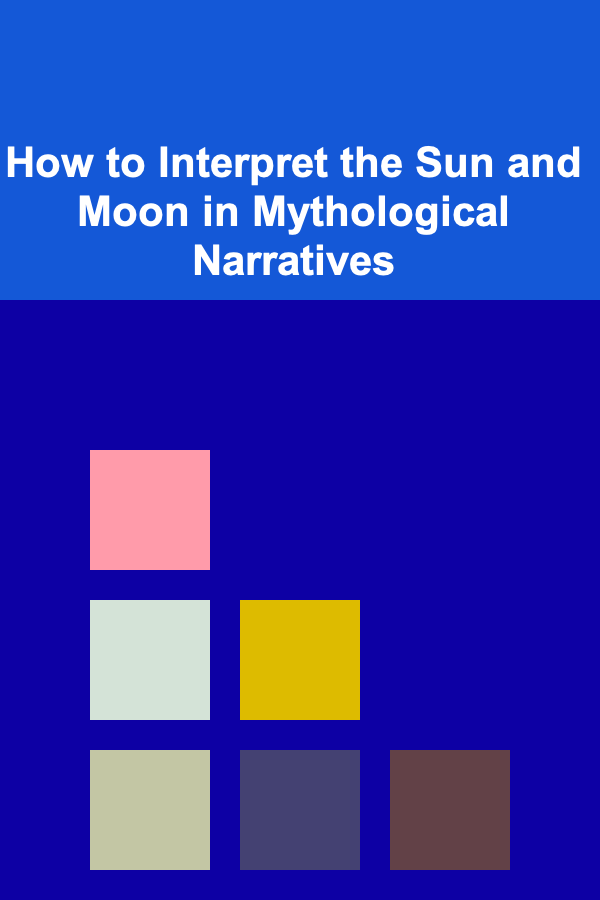
How to Interpret the Sun and Moon in Mythological Narratives
ebook include PDF & Audio bundle (Micro Guide)
$12.99$5.99
Limited Time Offer! Order within the next:

Mythology has been an intrinsic part of human culture for thousands of years, and the sun and moon, as celestial bodies that govern day and night, have always held significant symbolic roles in various cultures. From the dawn of civilization to the present day, these two celestial objects have been portrayed in myths, legends, and stories across the globe, often representing powerful gods, goddesses, and forces of nature. The importance of the sun and moon in mythological narratives goes far beyond their literal influence on the earth. In many cultures, these celestial bodies have been endowed with deep symbolic meanings, representing life, death, time, cycles, and the balance between opposites.
In this article, we will explore how the sun and moon are interpreted within mythological narratives, examining their roles as deities, their symbolic meanings, and their relationships to human existence. We will look at various mythologies from different parts of the world, such as Greek, Norse, Native American, Chinese, and African traditions, to gain a deeper understanding of how these celestial bodies are woven into the fabric of mythology.
The Sun and Moon as Deities
In many ancient cultures, the sun and moon were not just natural phenomena but powerful deities with human-like qualities and divine powers. These deities often represented opposites or complementary forces, symbolizing the eternal struggle and balance between light and dark, day and night, life and death. The relationship between the sun and moon, whether harmonious or antagonistic, often mirrors the cycles of human existence---birth, growth, decay, and renewal.
The Sun as a Deity
In various mythologies, the sun is often depicted as a male god or a masculine force, representing strength, vitality, and life. The sun is typically associated with the principle of creation and the giver of light and warmth. The sun god is often portrayed as a heroic figure, leading the heavens, protecting the earth, and bringing life to the world.
Greek Mythology: Helios and Apollo
In Greek mythology, Helios is the personification of the sun, often depicted as a powerful, radiant figure driving a chariot across the sky. He is one of the Titans and is believed to watch over the earth from his position in the sky. Helios's chariot is drawn by fiery horses, and his daily journey across the heavens symbolizes the sun's movement from east to west.
Later, Apollo, another important figure in Greek mythology, came to be associated with the sun. Though initially Apollo was not linked to the sun, his role as the god of light, music, and prophecy gradually merged with that of Helios. Apollo's connection to the sun reflects his power over life, healing, and the arts. He is often seen as a god of order, harmony, and rationality, embodying the pure, illuminating force of the sun.
Egyptian Mythology: Ra
In Egyptian mythology, the sun god Ra holds a central position. Ra is often depicted as a man with the head of a hawk, crowned with the sun disk. Ra was believed to journey through the underworld at night and be reborn every morning, symbolizing the eternal cycle of life, death, and rebirth. Ra is a creator god, and his power is associated with kingship and order. As the supreme deity of the ancient Egyptians, Ra represents the life-giving force of the sun, a symbol of divine protection and stability.
Hindu Mythology: Surya
In Hindu mythology, Surya is the god of the sun, one of the Adityas, who rides a chariot drawn by seven horses. Surya is considered a symbol of life, vitality, and health, often invoked for healing and protection. In the Vedic tradition, the sun is seen as a powerful source of spiritual light and knowledge, guiding the soul through the darkness of ignorance. Surya is also associated with the concept of time, as his movement across the sky marks the passage of the day.
The Moon as a Deity
In contrast to the sun, the moon is often depicted as a feminine force, representing cycles, intuition, and emotion. While the sun is associated with order, the moon is linked to chaos, change, and mystery. The moon, with its phases of waxing and waning, symbolizes the cyclical nature of life, including birth, growth, decay, and death. The moon's shifting phases also reflect the complexity of human emotions, intuition, and creativity.
Greek Mythology: Selene and Artemis
In Greek mythology, the moon is personified by the goddess Selene, who is depicted as driving a chariot across the night sky, similar to Helios with the sun. Selene is a peaceful and nurturing deity, often associated with the tides and the rhythm of nature. In some myths, Selene falls in love with the mortal Endymion, and they have children together, symbolizing the fertility and nurturing qualities of the moon.
Artemis, Selene's twin sister, is also closely associated with the moon. As the goddess of the hunt, wild animals, and childbirth, Artemis embodies the moon's more elusive and mysterious qualities. While Selene is the radiant moon goddess, Artemis is often depicted as a more active, youthful, and independent figure, representing the lunar force of change and transformation.
Norse Mythology: Mani
In Norse mythology, Mani is the personification of the moon. Mani and his sister Sol (the sun) were created by the gods to light the heavens. Mani drives a chariot across the sky, chased by a wolf, representing the moon's eternal pursuit and its eventual eclipse. The myth of Mani and Sol reflects the Norse belief in the cyclical nature of time, where light and darkness are constantly in flux, mirroring the changing seasons and the passage of time.
Native American Mythology: The Moon and Female Deities
In many Native American traditions, the moon is associated with female deities and plays a significant role in the spiritual lives of the people. For example, in the Iroquois tradition, the moon is represented by the goddess who rules over the night and is connected to fertility, women's health, and childbirth. The moon's cyclical nature is often linked to the menstrual cycle of women, further emphasizing its role as a symbol of fertility and growth.
In the Navajo tradition, the moon is also a central figure, with the moon goddess changing the seasons and controlling the tides. The moon is seen as a protector and a guide, watching over the people during the night and bringing renewal and balance.
The Sun and Moon in Relation to Each Other
In many mythologies, the sun and moon are not just individual deities but are seen as interconnected forces, often representing opposites that are in constant balance or tension. The relationship between the sun and moon can symbolize a variety of themes, such as the duality of existence, the balance between order and chaos, or the interconnectedness of masculine and feminine energies.
The Eternal Dance of the Sun and Moon
In many myths, the sun and moon are depicted as engaged in an eternal dance, one rising and setting as the other takes its place. This dance represents the balance between opposites---day and night, light and darkness, life and death. The idea that the sun and moon are eternally connected suggests that the cycles of nature are never-ending, and that all life exists within these cycles.
For example, in Egyptian mythology, the sun god Ra's journey through the underworld at night and his rebirth every morning reflects the balance between day and night. This daily cycle of death and rebirth also mirrors the cycle of the moon, which wanes and waxes, symbolizing growth and decay. In this way, the sun and moon are seen as two halves of a greater whole, one not existing without the other.
Solar and Lunar Eclipses: The Clash of Forces
One of the most dramatic and awe-inspiring events in the sky is the solar or lunar eclipse, which occurs when the sun, moon, and earth align in such a way that one body obscures the other. In many cultures, eclipses were seen as powerful and often ominous events. They were interpreted as moments of cosmic conflict, when the forces of day and night, light and dark, were in direct confrontation.
In Greek mythology, for example, eclipses were often seen as a sign of the gods' anger or as a harbinger of doom. Similarly, in Hindu mythology, eclipses were believed to be caused by the demon Rahu, who was chasing the sun and moon, attempting to devour them. The eclipse symbolized the triumph of darkness over light, though the sun and moon would always eventually reappear, signifying the restoration of order.
Conclusion
The sun and moon in mythology are much more than celestial bodies; they are symbolic representations of fundamental forces in the universe. Through their roles as deities, the sun and moon embody the cyclical nature of time, the balance between opposites, and the interconnectedness of all life. These mythological narratives reflect the human desire to understand the natural world and to seek meaning in the cosmic order.
Whether as symbols of creation, destruction, life, death, or renewal, the sun and moon continue to captivate our imaginations and shape our understanding of the universe. Through their stories, we are reminded of the eternal dance of light and darkness, and the delicate balance that sustains the world.

How to Choose the Best Toys for Your Pet's Mental Stimulation
Read More
How to Create a Budget-Friendly Seasonal Decor Plan
Read More
How To Create Engaging Story Time Experiences
Read More
How to Set Up a Productive Home Office for Remote Work
Read More
How to Replace a Door Knob: A Comprehensive Guide
Read More
How to Prepare Wholesome & Hearty Breakfast Burritos
Read MoreOther Products

How to Choose the Best Toys for Your Pet's Mental Stimulation
Read More
How to Create a Budget-Friendly Seasonal Decor Plan
Read More
How To Create Engaging Story Time Experiences
Read More
How to Set Up a Productive Home Office for Remote Work
Read More
How to Replace a Door Knob: A Comprehensive Guide
Read More